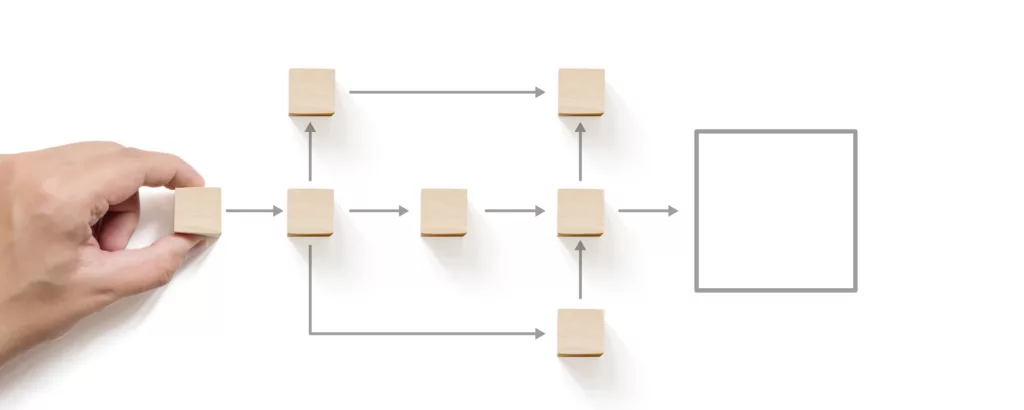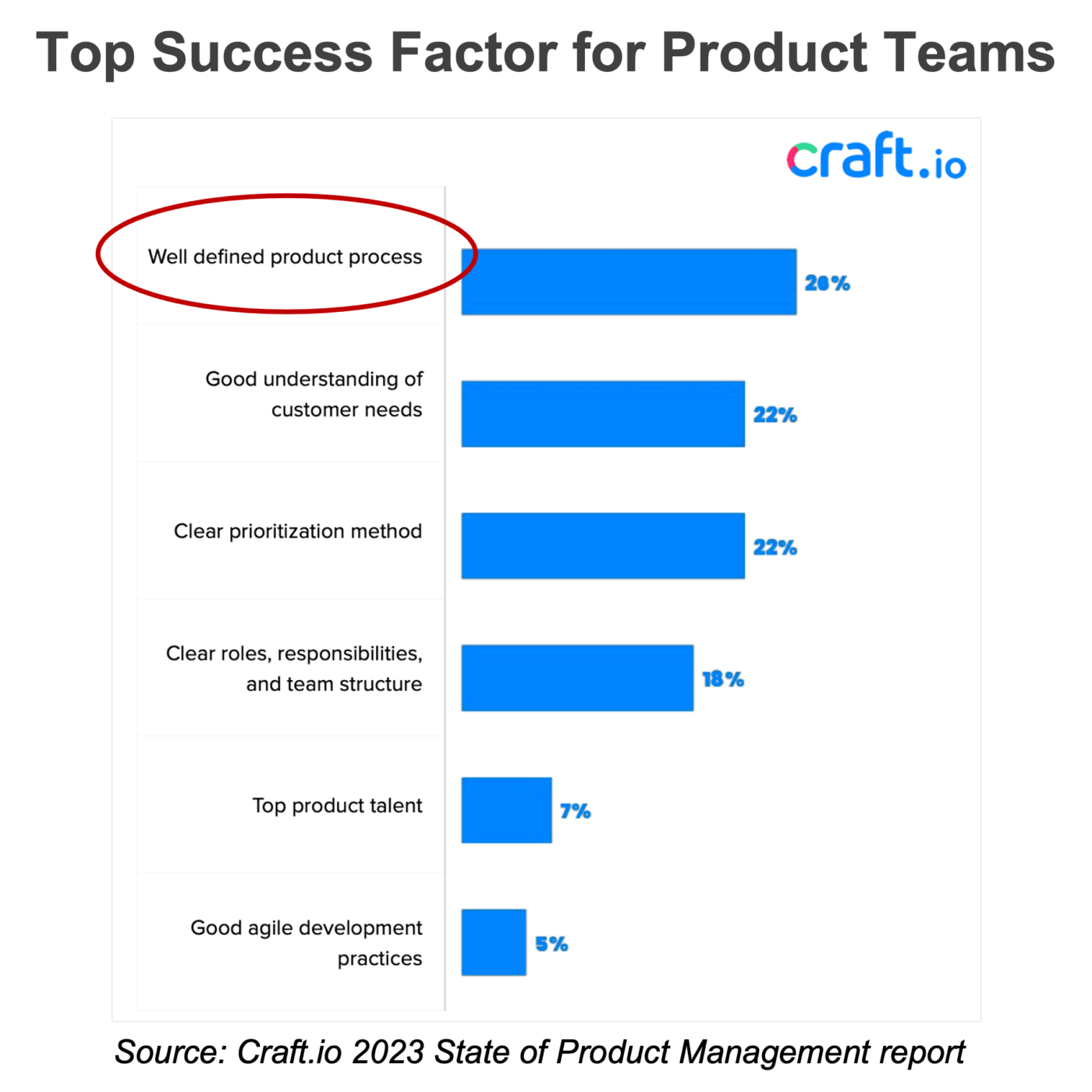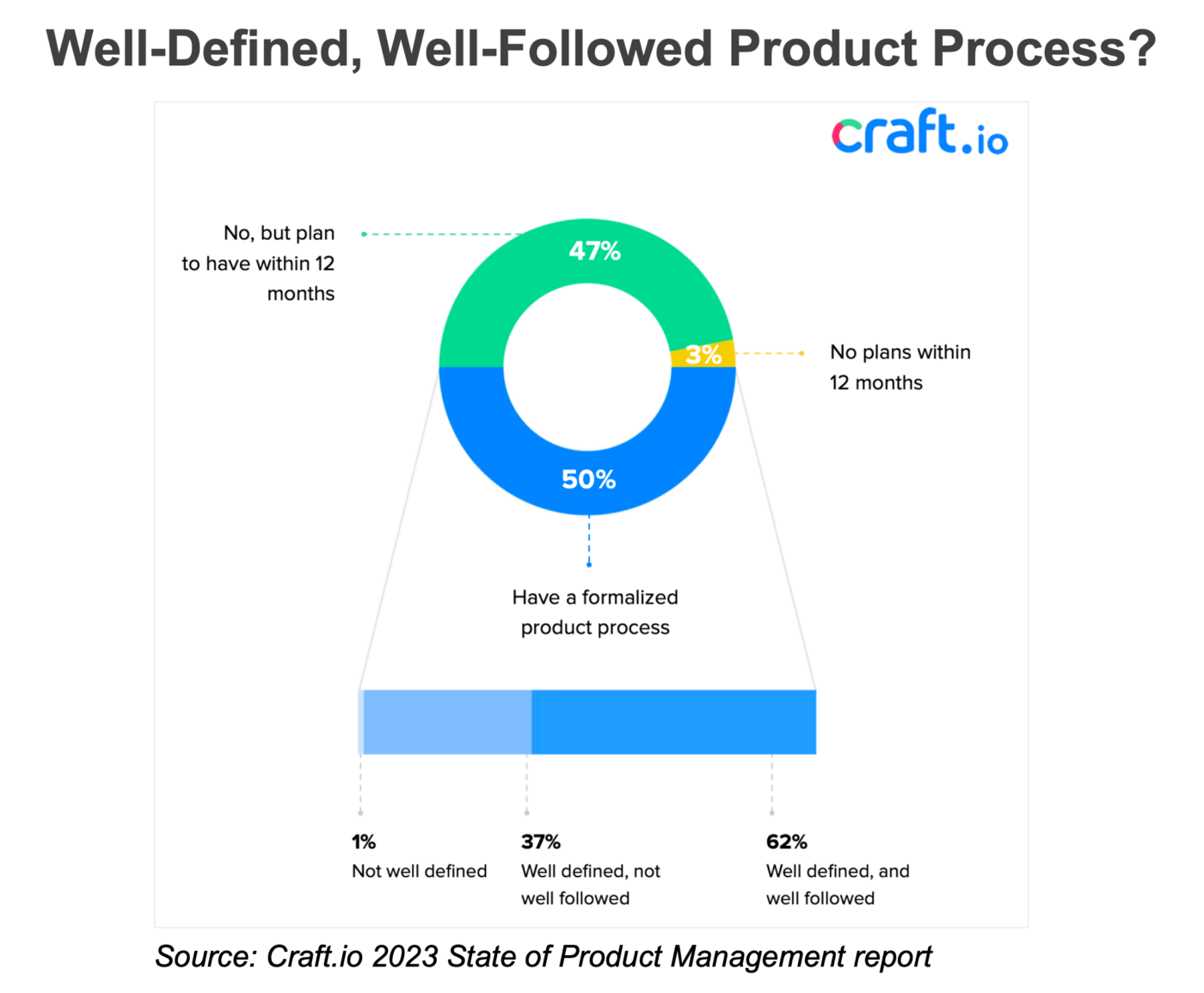Home > Blog > Demystifying the Product Development Process
Demystifying the Product Development Process

Yes, you need a product development process if you want to build and release successful products. But no, creating this process doesn’t need to be difficult. We’ll show you a simple, logical formula you can follow to give your products the best chances of success.
What Is the Product Development Process?
Many organizations view the product development process far too narrowly — thinking only in terms of the steps needed to build the product itself. But as a Product Manager, you know that’s only a small portion of what’s involved.
Filming a movie begins only after writing the script, obtaining funding, scouting locations, casting actors, hiring the crew, and a thousand other tasks. In a similar way, “developing” a product — meaning actually building it — can happen only after a team of product professionals has completed several other strategic steps. For example:
- Identifying an unresolved challenge or unmet need facing a segment of the market.
- Devising a concept for a solution to that challenge.
- Determining the market is large enough to make building the solution worthwhile.
- Researching for possible competitors (or alternative solutions to the challenge).
- Validating the idea with representatives of the persona group.
- Creating a prototype and sharing it with potential users for their input.
- Building and releasing a Minimum Viable Product (MVP) for market feedback.
The product development process encompasses everything from coming up with the concept for a product, through releasing the product to the market, and improving it over time.
Think of it this way: Decades after its launch, the product development process for Google’s search engine is still underway today.
What is the difference between product development and product management?
When you think of product development using its narrower definition — engineering a physical product or writing the code for a digital product — you can see the clear distinction from product management. A company doesn’t get to the “product development” phase until it knows what it wants to build. And the product management team carries out that role: devising the concept for the product, validating the concept, and coming up with a viable product strategy to get the product from idea to market launch.
The lines between product development and product management become blurry when you think of the development process using the more expansive definition we’re using in this post — including all of the strategic steps needed to bring a product from concept through release and then through continuous improvement throughout its market lifecycle.
How the right product development process can give you a competitive advantage
When we surveyed product professionals around the world for our craft.io 2023 State of Product Management Report, we found that the most common success factor they identified was having a well-defined product development process.

But as much value as these professionals place on having an effective process for bringing products from concept through market launch, only 31% said they do. As you can see from the chart here, nearly half of product teams have no formal development process at all — and many of those with a process aren’t satisfied with it.

In other words, if your team can implement and follow an effective process for creating products, you can gain an advantage over many of your competitors. And in the next section, we’ll walk you through such a process step by step.
The 6 Stages of Product Development
You can find many variations of product development broken into different numbers of steps or phases. Our favorite is the 6-stage product development process published by Indeed. Here’s a summary of their guide to the process:
Stage 1: Ideation
This is the earliest phase, when product teams search for gaps and opportunities in the market — usually unmet needs — and then brainstorm ideas for addressing those unmet needs.
Stage 2: Product definition
If the team coalesces around an idea to solve a specific market challenge, the next step will be to begin defining broadly what the product will do, researching the market for any competitors, and coming up with success metrics for the product.
Note: Although the Indeed description doesn’t include this, we would add to this stage (or insert a new stage immediately after this one) a “validation” step where the team speaks with representatives of the persona group to determine their initial interest in such a product.
Stage 3: Prototyping
Now the team can begin creating a rough sketch of the product. This can range from a simple drawing, to a more detailed wireframe, to a highly detailed and software-rendered design. When they’ve received approval from their senior management team to move forward, the team will use the prototype as the basis to build a Minimum Viable Product (MVP) and can even begin setting development milestones and deadlines.
Stage 4: Initial development
At this stage, the team builds the MVP, shares it with both internal stakeholders and potential customers for initial feedback, and leverages this information to adjust and improve the product.
Stage 5: Testing
With an updated, feedback-informed version of the product ready, the team will test it for bugs, errors, usability, and other performance issues.
Note: No matter which product development process you choose to implement, you’ll want to make sure to create at least one stage for testing before you release the product to the market.
Stage 6: Market launch
Finally, the team is ready to release the product to the market.
And as you’ve probably gathered if you’ve read this far, the market release is not the end of the product development process — it is only a transition to the next phase of the process. From this point forward, your team will be analyzing user feedback, monitoring the competitive landscape, and continuing to brainstorm — all to help you identify new ways to improve and enhance the product.
What Are the Common Flows of the Product Development Process?
In most cases, you’ll find that your product development process does not take place in a linear way. In other words, you won’t always go straight from one step to the next. Instead, you’ll find your team regularly revisiting earlier stages and, in some cases, having to start over completely.
The 6-stage process we just outlined is a great way to set up your product team’s methodology for bringing new products from concept to market success. But you need to view that plan as the ideal, not something you’ll attain with every new product idea. Be prepared to take some steps backward and to cycle through some stages several times before moving forward. Here are a few examples of common flows in product development.
From validation back to ideation:
You take your idea out to a group of potential customers to determine if it’s viable, and you discover that most of these people find the product concept interesting but not something they’d pay for. So it’s back to the ideation stage.
From testing back to initial build… and then back again the testing:
While testing your MVP, your QA team and other internal stakeholders discover several errors or defects in the product. It’s a good thing you included a testing stage, right? Now that you’ve caught and documented these issues, you can send the MVP back into development for fixes and improvement.
And after your dev team has addressed those issues, you’ll want to send the updated version of the MVP back through the same QA process — to make sure you’ve caught and fixed everything.
From initial build back to prototyping:
After building your product’s MVP and running it by internal and external stakeholders, you realize this version of the product doesn’t fully solve the main challenge confronting your persona. So you need to go back to the sketching/wireframing/prototyping stage to flesh out the product’s functionality.
Ready to Start Formalizing Your Product Development Process?
The first step is to bring all of your company’s product content — backlogs, roadmaps, strategic input, feedback, prioritization, capacity planning, etc. — into a central product management hub.



